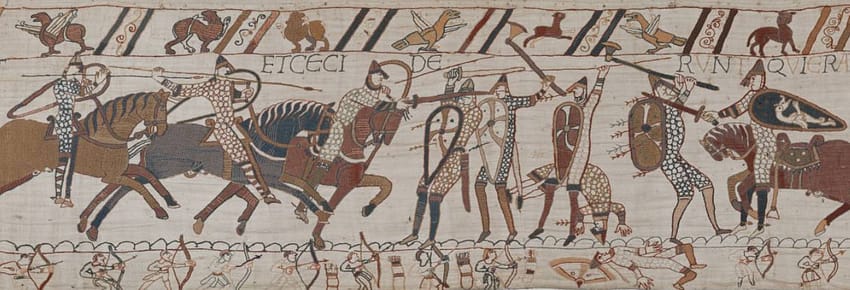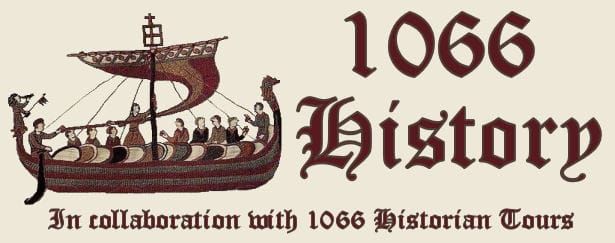The Norman Conquest is the name given to the invasion and subsequent conquest of England.
This Norman Conquest timeline gives the date and details of the main events that led to the end of the Anglo-Saxon period and the beginning of Norman rule.

Norman Conquest Timeline 1064 – 1074
1064 (exact date not known)
Harold Godwinson is shipwrecked off the coast of Normandy. He is taken before William, Duke of Normandy.
1065 (exact date not known)
Battle of Dinan
Harold joins William’s army in this battle against Conan II of Brittany. He distinguishes himself by pulling Norman soldiers from quicksand.
1065 (exact date not known)
Harold returns to England with his nephew Hakon who, along with Harold’s younger brother Wulfnoth, had been William’s prisoner since 1052. William later claims that before leaving Harold swore an oath on holy relics to uphold William’s claim to the English throne.
1065 November
Harold exiles his brother Tostig, Earl of Northumbria, after the people rebel against his harsh rule. Tostig vows revenge on his brother.
1066 (4th or 5th January)
King Edward the Confessor dies, leaving the English throne’s succession unclear.
1066 (6th January)
Harold Godwinson is crowned King of England
1066 (around 15th January)
William, Duke of Normandy, learns of Harold’s coronation. He begins making plans to challenge Harold’s rule.
1066 (Spring)
Harold stations men along the south coast, anticipating an invasion by William.
1066 (May)
William sends an envoy to the Pope requesting backing for his invasion. The Pope sides with William and sends a Papal flag for him to take into battle.
1066 (Summer)
Tostig Godwinson meets with Harald Hardrada, King of Norway, and they plan an invasion of England.
1066 (8th September)
Harold Godwinson sends his men home to help with the harvest. He believes it is too late in the year for William to invade.
1066 (8th September)
Harald Hardrada’s Viking fleet reaches the River Tyne. He meets with Tostig Godwinson and begins raiding the north.
1066 (11th September)
Harold Godwinson learns of the Viking invasion. He begins assembling an army to march north.
1066 (13th / 14th September)
William’s invasion fleet leaves the mouth of the River Dives to sail to England. However, bad weather blows the ships east to St Valery sur Somme.
1066 (18th September)
Harald Hardrada’s Viking army enters the Humber estuary. It then sails along the River Ouse to Riccall before proceeding on foot towards York.
1066 (20th September)
Battle of Fulford
Harold Hardrada defeats the northern English earls Edwin and Morcar at Fulford.
1066 (24th September)
Harald Hardrada takes York.
1066 (25th September)
Battle of Stamford Bridge
Harold Godwinson makes a surprise attack on the Viking army as they exchange prisoners taken at Fulford. Harold’s Saxon army have some difficulty taking the Bridge where the exchange takes place. Hardrada is killed soon after the bridge is secured and Tostig Godwinson dies soon after.
1066 (27th September)
William of Normandy finally sets sail from St Valery sur Somme for England with a fleet of 700 / 800 ships.
1066 (28th September)
William lands at Pevensey on the south coast of England. He begins constructing a wooden castle inside the walls of the Roman fort of Anderida. He sends scouts out to pillage food for his huge army.
1066 (30th September)
Unable to find sufficient food in Pevensey, William decamps and marches to Hastings. Here he builds another wooden castle on the cliffs overlooking the sea.
1066 (1st October)
Messengers inform Harold Godwinson of William’s invasion. He and his housecarls ride south to London mustering a new army along the way. He tells the foot soldiers who fought at Stamford Bridge, to follow as soon as they are able.
1066 (6th October)
Harold reaches London and issues an order for men to join him in London.
1066 (10th October)
Harold and his army leave London and march south. He leaves instructions for those that follow to muster at the old hoar apple tree.
1066 (13th October)
The Anglo-Saxon army camps on Caldbec Hill.
1066 (14th October)
Battle of Hastings
As the Norman army approaches, Harold’s army forms a shield wall along the top of Senlac Hill. The battle begins at 9am and continues all day. As dusk is falling, Harold is struck by an arrow to the head, as he reels from the blow he is cut down and killed. Harold’s standard bearer, Ansgar, is badly wounded but survives and goes to London.
1066 (15th October)
William summons Edyth Swanneck to identify Harold’s body. The body is given to William Malet to dispose of. Its location remains unknown.
1066 (15th October)
Rather than submit to William, the Witan declare Edgar Aetheling King of England.
1066 (around 17th October)
William determines to conquer England and leaves Hastings. He sends a force of around 500 cavalry to secure the bridge across the Thames at Southwark. He then marches to Dover where another wooden castle is erected.
1066 (around 20th October)
Harold’s mother, Gytha and his children flee to Exeter where they try to raise a force against William.
1066 (late October)
Burning of Southwark
Williams force of 500 cavalry reach Southwark where they were met by a Saxon force raised by Ansgar. The Normans defeated the Saxons but were unable to hold the bridge. In retaliation they set fire to Southwark razing it to the ground.
1066 (late October)
William took control of Canterbury, securing Kent.
1066 (late October / November)
William plans to march on London. Having learned of the resistance at Southwark, he takes a route south, then west of London, crossing the Thames at Wallingford.
1066 (mid / late November)
William leads half his army to Berkhamsted blocking the approach to London from the Midlands. The other half of his army approach London from Maidenhead blocking Western supply routes.
1066 (late November)
William receives the submission of Edgar Aetheling, Earl Morcar, Earl Edwin and surviving members of the Witan.
1066 (December)
William enters London.
1066 (25th December)
William is Crowned King of England in Westminster Abbey.
1067 (January)
William begins distributing English lands to his nobles.
1067 (March)
William returns to Normandy, leaving England in the hands of his half-brother Odo of Bayeux and William FitzOsbern.
1067 (August)
Eadric the Wild’s Resistance
Following the confiscation of his land in Hereford, Eadric allies with Bleddyn ap Cynfyn Prince of Gwynned and Powys and attempts to regain Hereford before retreating to Wales.
1067 (December)
William returns to England in response to growing unrest. He gives land in rebellious regions to trusted men.
1068 (Spring)
Edgar Aetheling goes to Scotland and seeks support of King Malcolm III.
1068 (May)
William places the city of Exeter, centre of resistance in the west, occupied by Harold Godwinson’s family, under siege. After 18 days the city surrenders. Harold’s family escape the city and flee abroad.
1068 (Summer)
Earls Edwin and Morcar mount a resistance against William in Mercia. William marches north and the Earls surrender.
1068 (Summer)
Battle of Bleadon
Harold Godwinson’s sons, Godwin, Edmund and Magnus, return with a fleet of 52 ships. They attempt to take Bristol but are repelled by a Saxon force led by Eadnoth the Staller, fearful of William’s wrath. Magnus is killed, Godwin and Edmund flee abroad.
1069 (Early)
Rebellions erupt in Northumbria, led by Edgar Aetheling, supported by King Malcolm III of Scotland. The Normans suppress the rebellion, but unrest continues.
1069 (September)
King Sweyn Estridsson of Denmark lands with a fleet in support of the English rebels. The combined forces lay siege to York.
1069 (October)
William leads a force to York, defeating the rebels and the Danes. The Danes retreat.
1069-1070 (Winter)
The Harrying of the North
William begins a scorched-earth campaign across Northumbria to supress the rebellions north. Villages are burned, and thousands of people are slaughtered. Those that survive die of starvation.
1070 (April)
Papal legates depose Archbishop Stigand, removing the last significant Anglo-Saxon cleric from power and consolidating Norman control over the English Church.
1070 (May 1070)
Hereward the Wake’s Rebellion
King Sweyn of Denmark returns and joins forces with Hereward the Wake in the Ely Fens.
1070 (Summer)
Hereward the Wake’s Rebellion
Resistance continues in East Anglia, led by Hereward the Wake. The rebels raid Peterborough Abbey.
1071 (During)
Hereward the Wake’s Rebellion
King Sweyn withdraws his support for the rebels after William pays him off. Earl Morcar joins Hereward the Wake. They mount a guerrilla war against the Normans.
1071 (During)
Earl Edwin is betrayed by his own men and killed while travelling north to join Edgar Aetheling.
1071 (September)
Hereward the Wake’s Rebellion
William’s forces capture the Isle of Ely after being shown a secret route to the island by a monk. Morcar is captured and imprisoned. Hereward the Wake disappears from records, most likely fleeing abroad.
1072 (During)
William invades Scotland and Malcolm III is forced to submit to William and sign the Treaty of Abernethy. Edgar Aetheling is exiled.
1074 (During)
Edgar Aetheling returned to England and submitted to William.
